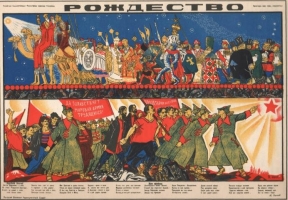About Special Collections
The special collections represent a specific part of the collection of the Slavonic Library. According to its origin and content, we can divide them into two parts:
- Collections created within the Slavonic Library
- Collections created by other persons or institutions later acquired by the Slavonic Library

From the collection of posters – “Christmas” painted by Dmitrii S. Moor
The first part consists of four large and developing collections:
- The collection of paper documents
- The collection of picture material
- The collection of maps
- The collection of posters
All of them are various, developing collections containing materials of different origins, importance, extent or age. The only unifying aspect is the type.
The bulk of the second part is in a number of collections of various contents and volumes. However, every single one creates a logical and compact unit. We can find both complete collections (inheritance of Antonii V. Florovskii, the collection of administrative documents of the Russian Historical Archive Abroad) and collection fractions (personal or family correspondence, parts of documents from institutions etc.).
Most of the collections deal with Russian and Ukrainian emigration in inter-war Czechoslovakia. The Slavonic Library acquired them after the WWII for the most part, when most of emigrants' organizations and elites disappeared. Under such conditions, the library gained parts of the collection of documents from the cancelled Museum of the Struggle for Liberation of Ukraine or administrative documents of the Russian Historical Archive Abroad acquired in the late 1940s. Such collections as Petr N. Savitskii's personal inheritance, for example, were given to the Slavonic Library by the family after death of the person. And lastly, we have been still discussing the origin of some collections like operational documents from the M. Drahomanov's Ukrainian Pedagogical Institute and other Ukrainian emigrant institutions, for instance.
Besides the mentioned ones, there are other appreciated and often researched collections such as correspondence of the poet Lesia Ukrainka or the large collection of images made by Ukrainian émigrés (mainly students and teachers of the Ukrainian Studio of Fine Arts in Prague) during the inter-war era or the collection of Alfred L. Bem's inheritance.
Except for collections about Russian and Ukrainian emigration, we can find here, for instance, an archive of scraps of articles about Yugoslavia from Czechoslovakian press between 1934 and 1939. Very rare is the collection of photographs set on glass that were created by the Czech photographer Karel Hulka in Eastern Slovakia, Galicia and Carpathian Ruthenia in the break of the 1920s and 1930s.